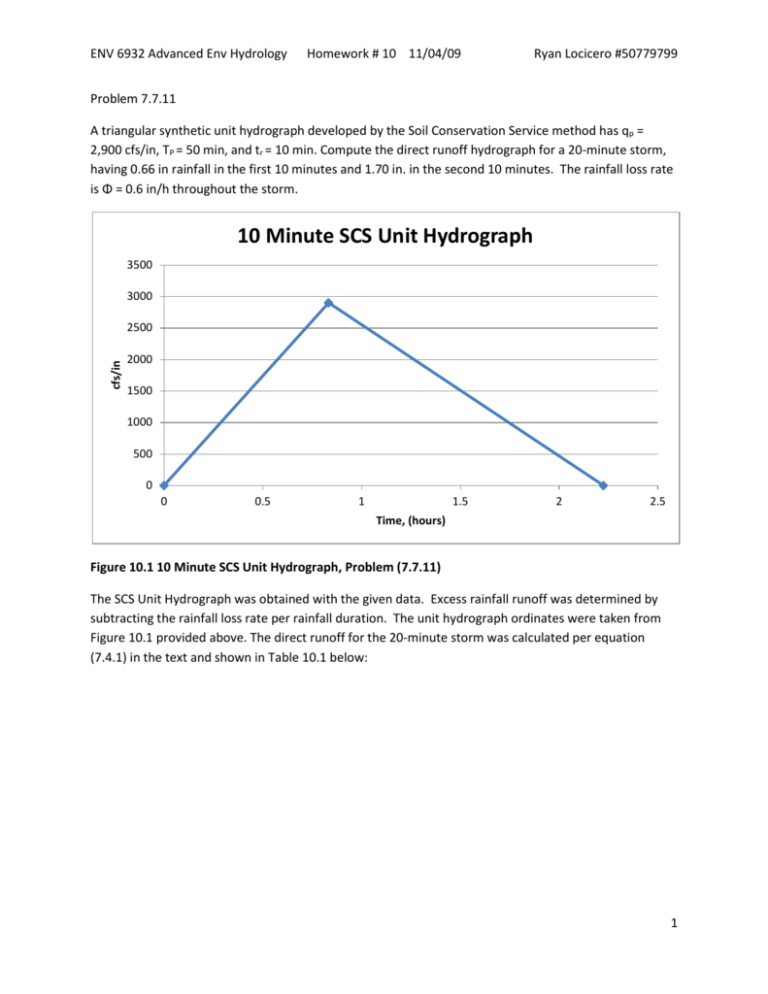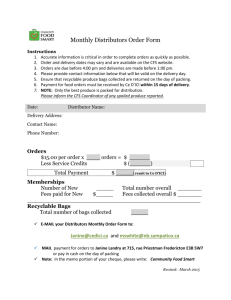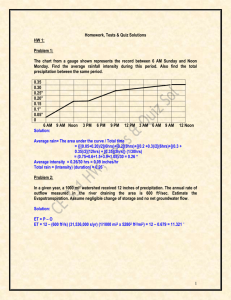Consider a 2-acre detention basin with vertical walls. The
advertisement

ENV 6932 Advanced Env Hydrology Homework # 10 11/04/09 Ryan Locicero #50779799 Problem 7.7.11 A triangular synthetic unit hydrograph developed by the Soil Conservation Service method has qp = 2,900 cfs/in, TP = 50 min, and tr = 10 min. Compute the direct runoff hydrograph for a 20-minute storm, having 0.66 in rainfall in the first 10 minutes and 1.70 in. in the second 10 minutes. The rainfall loss rate is Φ = 0.6 in/h throughout the storm. 10 Minute SCS Unit Hydrograph 3500 3000 cfs/in 2500 2000 1500 1000 500 0 0 0.5 1 1.5 2 2.5 Time, (hours) Figure 10.1 10 Minute SCS Unit Hydrograph, Problem (7.7.11) The SCS Unit Hydrograph was obtained with the given data. Excess rainfall runoff was determined by subtracting the rainfall loss rate per rainfall duration. The unit hydrograph ordinates were taken from Figure 10.1 provided above. The direct runoff for the 20-minute storm was calculated per equation (7.4.1) in the text and shown in Table 10.1 below: 1 ENV 6932 Advanced Env Hydrology Time (X10-min) n=9 1 2 3 4 5 6 7 8 9 10 11 12 13 14 Total: Excess Precipitation (in) 0.56 1.60 Homework # 10 11/04/09 Unit hydrograph ordinates (cfs/in) 10 20 30 40 50 60 580 1160 1740 2320 2900 2552 325 928 650 1856 974 2784 1299 3712 1624 4640 1429 4083 2.2 70 2205 1235 3528 80 1858 1040 2973 Ryan Locicero #50779799 90 1510 100 1163 110 816 120 468 130 121 845.6 2416 651.28 1860.8 456.96 1305.6 262.08 748.8 67.76 Direct runoff (cfs) 325 1578 2830 4083 5336 6069 5318 4568 3818 3067 2318 1568 817 Total : 41,695 Table 10.1 Direct Runoff Calculations (Problem 7.7.11) 2 ENV 6932 Advanced Env Hydrology Homework # 10 11/04/09 Ryan Locicero #50779799 Problem 8.2.3 Solve for problem 8.2.2 assuming the initial reservoir storage is 87.5 X 106 m3. Use the level pool routing method to route the hydrograph below through the reservoir whose storageoutflow characteristics are given in Prob. 8.2.1. What is the maximum reservoir discharge and storage? Design Hydrograph Data Time (h) 0 2 4 6 8 10 12 14 16 18 Inflow (m3/sec) 60 100 232 300 520 1,310 1,930 1,460 930 650 Reservoir Storage Characteristics: Storage (106 m3) 75 81 87.5 100 110.2 Outflow (m3) 57 227 519 1330 2270 Δt = 2 hr or 7200 s. This problem is solved by first determining the Storage-outflow function, this function is described below: 2𝑆 + 𝑄 𝛥𝑡 Example illustrating Storage-outflow function with storage, S = 87.5 x 106 m3 and Q = 519 m3/s 2 ∗ 87.5 x 106 m3 m3 + 519 = 24,824 m3/s 7,200 𝑠 s See Table 10.2 for a complete list of Storage-outflow function calculations Table 10.2 Storage-outflow function, Problem (8.2.3) Discharge Q Storage S (2S/Δt) +Q (m3/s) 0 57 227 519 1330 2270 (X106 m3) 0 75 81 87.5 100 110.2 m3/s 20,890.33 22,727.00 24,824.56 29,107.78 32,881.11 3 ENV 6932 Advanced Env Hydrology Homework # 10 11/04/09 Ryan Locicero #50779799 In this problem the initial reservoir storage was 87.5 X 106 m3 resulting in an initial discharge of 519 m3/2. The corresponding storage-outflow function value provided an initial 2𝑆𝑗+1 𝛥𝑡 + 𝑄𝑗+1 as shown in Table 10.3. With the outflow value then known we can calculate the next unknown variable and use the Storage-outflow function to determine the subsequent outflow value. These steps are outlined below. 2𝑆2 2𝑆2 − 𝑄2 = ( + 𝑄2 ) − 2𝑄2 𝛥𝑡 𝛥𝑡 2𝑆2 − 𝑄2 = (24,984 − 2 ∗ 549) = 23,886 𝑐𝑚𝑠 𝛥𝑡 This is the value in column 5. This value is then added to the value in column 4 (j+1), to determine the value for column 6 (j+1). The value generated in column 6 is then referenced to the storage outflow function to determine an Outflow value, column 7. This is repeated until all inflow data is analyzed. See Table 10.3 below: Table 10.3 Routing of a flow through a detention reservoir by the level pool method. Problem (8.2.3) Column: 1 2 3 4 5 6 7 Time Time Inflow Ij + Ij+1 (2Sj/Δt)- Q (2Sj+1/Δt) + Qj+1 Outflow index j (hr) (cms) (cms) (cms) (cms) (cms) 1 0 60 60 24,824.00 2 2 100 160 23,886.00 24,984 549 3 4 232 332 23,350.00 24,218 434 4 6 300 532 23,108.00 23,882 387 5 8 520 820 23,140.00 23,928 394 6 10 1,310 1,830 23,878.00 24,970 546 7 12 1,930 3,240 25,212.00 27,118 953 8 14 1,460 3,390 26,134.00 28,602 1,234 9 16 930 2,390 26,086.00 28,524 1,219 10 18 650 1,580 25,552.00 27,666 1,057 519 The maximum Outflow from the data is given in Table 10.3 as 1,234 m3/s. This relates to a total storage of 98.5 X 106 m3 determined interpolating the reservoir storage characteristics given. 4 ENV 6932 Advanced Env Hydrology Homework # 10 11/04/09 Ryan Locicero #50779799 Problem 8.2.4 Solve Example 8.2.1 in the text if the initial depth in the reservoir is 2 ft. How much higher does this make the maximum water level in the reservoir compared with the level found in Example 8.2.1? Problem 8.2.4 was solved with the same procedure as the previous problem (8.2.3) with the data given in Example 8.2.1. The initial reservoir depth of 2 ft was used resulting in a t=0 outflow rate of 30 cfs and column 5 equal to 320 cfs as calculated in Table 10.4. See Tables below for calculated data. Table 10.4 Storage-outflow function for determined detention reservoir (Problem 8.2.4) 1 Elevation H ft 0.5 1.0 1.5 2.0 2.5 3.0 3.5 4.0 4.5 5.0 5.5 6.0 6.5 7.0 7.5 8.0 8.5 9.0 9.5 10.0 2 Discharge Q cfs 3 8 17 30 43 60 78 97 117 137 156 173 190 205 218 231 242 253 264 275 3 Storage S ft3 21,780 43,560 65,340 87,120 108,900 130,680 152,460 174,240 196,020 217,800 239,580 261,360 283,140 304,920 326,700 348,480 370,260 392,040 413,820 435,600 4 (2S/Δt) +Q cfs 76 153 235 320 406 496 586 678 770 863 955 1,044 1,134 1,221 1,307 1,393 1,476 1,560 1,643 1,727 5 ENV 6932 Advanced Env Hydrology Homework # 10 11/04/09 Ryan Locicero #50779799 Table 10.5 Routing of flow through a detention reservoir by the level pool method (Problem 8.2.4) Column: 1 2 Time 3 4 Time Inflow (min) 0 (cfs) 1 2 3 4 5 6 7 8 9 10 11 12 13 14 15 10 20 30 40 50 60 70 80 90 100 110 120 130 140 16 17 18 19 20 21 22 150 160 170 180 190 200 210 index j 5 Ij + Ij+1 (cfs) 60 - (2Sj/Δt)- Q 7 (2Sj+1/Δt) + Qj+1 Outflow - (cfs) 320.00 180 300 420 540 660 680 600 520 440 360 280 200 120 302.00 367.20 479.00 610.00 764.40 954.20 1,108.80 1,163.80 1,145.40 1,072.80 960.40 824.80 686.40 556.80 380.0 482.0 667.2 899.0 1,150.0 1,424.4 1,634.2 1,708.8 1,683.8 1,585.4 1,432.8 1,240.4 1,024.8 806.4 39.0 57.4 94.1 144.5 192.8 235.1 262.7 272.5 269.2 256.3 236.2 207.8 169.2 124.8 - 436.40 339.00 273.36 227.76 196.16 170.76 151.06 596.8 436.4 339.0 273.4 227.8 196.2 170.8 80.2 48.7 32.8 22.8 15.8 12.7 9.9 60 120 180 240 300 360 320 280 240 200 160 120 80 40 6 40 (cfs) (cfs) 30.0 The maximum water level is calculated with by interpolating the values calculated in Table 10.4 at the maximum outflow value of 272.5 cfs resulting in a maximum stage or water level of 9.89 ft. an increase of 0.12 ft or 1.44 inches. The max water level calculated in the example is 9.77 ft. 6 ENV 6932 Advanced Env Hydrology Homework # 10 11/04/09 Ryan Locicero #50779799 Problem 8.2.6 Consider a 2-acre detention basin with vertical walls. The triangular inflow hydrograph increases linearly from zero to a peak of 540 cfs at 60 min and then decreases linearly to a zero discharge at 180 min. Route the inflow hydrograph through the detention basin using the head-discharge curve for the 5-ft pipe spillway in Table 8.2.2. The pipe is located at the bottom of the basin. Assuming the basin is initially empty, use the level pool routing procedure with a 10-minute time interval to determine the maximum depth in the detention basin. The routing is set up using the specifications given in the problem. The storage outflow function data for a 5 ft RCP was taken from Table 8.2.2. A Discharge-Elevation Relationship was developed for values that were outside of the given table. A trendline was set to this relationship and provided an equation for which additional storage outflow relationship was analyzed. Discharge Elevation Relationship 300 y = 0.0439x4 - 1.2741x3 + 11.46x2 - 3.672x Discharge, Q (cfs) 250 200 150 100 50 0 0.0 2.0 4.0 6.0 8.0 10.0 12.0 Elevation, H (ft) Figure 10.2 Dishcarge-Elevation Relationship for 5ft Diameter RCP Problem 8.2.6 was solved with the same procedure as the previous problem (8.2.3). See Table 10.6 and 10.7 for the Storage-outflow function for a given reservoir and routing of flow through a detention reservoir by the level pool method. 7 ENV 6932 Advanced Env Hydrology Homework # 10 11/04/09 Ryan Locicero #50779799 Table 10.6 Storage-outflow function (problem 8.2.6) 1 Elevation H 2 Discharge Q 3 Storage S 4 (2S/Δt) +Q ft cfs ft3 cfs 0.5 1.0 1.5 2.0 2.5 3.0 3 8 17 30 43 60 43,560 87,120 130,680 174,240 217,800 261,360 148 298 453 611 769 931 3.5 78 304,920 1,094 4.0 4.5 5.0 5.5 6.0 6.5 7.0 7.5 8.0 8.5 9.0 9.5 10.0 10.5 11.0 11.5 12.0 12.5 13.0 13.5 14.0 14.5 97 117 137 156 173 190 205 218 231 242 253 264 275 284 293 304 315 328 344 363 385 413 348,480 392,040 435,600 479,160 522,720 566,280 609,840 653,400 696,960 740,520 784,080 827,640 871,200 914,760 958,320 1,001,880 1,045,440 1,089,000 1,132,560 1,176,120 1,219,680 1,263,240 1,259 1,424 1,589 1,753 1,915 2,078 2,238 2,396 2,554 2,710 2,867 3,023 3,179 3,333 3,488 3,643 3,800 3,958 4,119 4,283 4,451 4,624 8 ENV 6932 Advanced Env Hydrology Homework # 10 11/04/09 Ryan Locicero #50779799 Table 10.7 Routing of flow through a detention reservoir by the level pool method, Problem (8.2.6) Column: 1 2 Time 3 4 5 6 7 Time Inflow Ij + Ij+1 (2Sj/Δt)- Q (2Sj+1/Δt) + Qj+1 Outflow (cfs) (cfs) (cfs) (cfs) (cfs) 1 (min) 0 2 3 4 5 6 7 8 9 10 11 12 13 14 15 16 17 18 10 20 30 40 50 60 70 80 90 100 110 120 130 140 150 160 170 19 20 21 22 180 190 200 210 index j 90 90 180 270 360 450 540 495 450 405 360 315 270 225 180 135 90 45 - 270 450 630 810 990 1,035 945 855 765 675 585 495 405 315 225 135 45 - - - 86.36 333.56 694.56 1,114.76 1,576.96 2,103.16 2,593.94 2,945.74 3,170.74 3,283.14 3,302.14 3,242.54 3,116.74 2,930.74 2,688.34 2,400.74 2,076.94 90.0 356.4 783.6 1,324.6 1,924.8 2,567.0 3,138.2 3,538.9 3,800.7 3,935.7 3,958.1 3,887.1 3,737.5 3,521.7 3,245.7 2,913.3 2,535.7 1.8 11.4 44.5 104.9 173.9 231.9 272.1 296.6 315.0 326.3 328.0 322.3 310.4 295.5 278.7 256.3 229.4 1,733.94 1,427.94 1,193.14 1,014.32 2,121.9 1,733.9 1,427.9 1,193.1 194.0 153.0 117.4 89.4 The maximum depth was determined by interpolating the storage-outflow function relationship relating to Elevation. The maximum outflow of 328 cfs results in a maximum depth of 12.5 ft 9 ENV 6932 Advanced Env Hydrology Homework # 10 11/04/09 Ryan Locicero #50779799 Problem 8.3.8 In this problem, you are to determine the runoff from a particular watershed and route the runoff hydrograph through a reservoir at the downstream end of the watershed. The reservoir has the following storage-outflow characteristics: Storage (ac*ft) Outflow (cfs) 0 0 200 2 300 20 400 200 500 300 600 350 700 450 1100 1200 0.0 0.5 1.0 1.5 2.0 0.0 1.0 3.0 4.0 4.5 0.00 0.50 1.00 1.50 2.00 2.50 3.00 3.50 0 4.00 200 4.50 500 5.00 800 5.50 700 6.00 600 500 400 300 200 100 50 0 The rainfall is: Time (h) Accumulated rainfall depth (in) The half hour unit hydrograph is: Time (h) Discharge (cfs/in) Time (h) Discharge (cfs/in) The phi-index is 0.8 in/hr is to be used to account for losses. Determine the peak discharge from the reservoir assuming zero baseflow. What is the area in square miles of the watershed? The unit hydrograph data was used to determine the direct runoff for the watershed. To account for abstractions the Phi-Index was subtracted from accumulated rainfall depth data before plugging it into the spreadsheet for calculation. See Table 10.8 10 ENV 6932 Advanced Env Hydrology Homework # 10 11/04/09 Ryan Locicero #50779799 Table 10.8 Calculation for Direct Runoff Hydrograph, (Problem 8.3.8) Time (0.5 hours) n=9 1 2 3 4 5 6 7 8 9 10 11 12 13 14 Total: Excess Precipitation 0.5 (in) 200 0.60 120 2.60 520 3.60 720 4.10 820 Unit hydrograph ordinates (cfs/in) 1.0 1.5 2.0 2.5 500 800 700 600 300 1300 1800 2050 480 2080 2880 3280 420 1820 2520 2870 360 1560 2160 2460 3.0 500 300 1300 1800 2050 3.5 400 240 1040 1440 1640 4.0 300 180 780 1080 1230 4.5 200 120 520 720 820 10.9 5.0 100 60 260 360 410 5.5 50 30 130 180 205 Direct runoff (cfs) 120 820 2500 5120 7110 7660 6570 5480 4390 3300 2240 1310 590 205 Total : 47,415 The storage-outflow function was determined and extrapolated for use in this problem. See Table 10.9 and Figure 10.3 11 ENV 6932 Advanced Env Hydrology Homework # 10 11/04/09 Ryan Locicero #50779799 Discharge-Storage Relationship 1,400 1,200 Discharge, Q (cfs) 1,000 800 600 400 200 - 200 400 (200) 600 800 1,000 1,200 Storage (ac-ft) Figure 10.3 Discharge-Storage Relationship, Problem 8.3.8 Table 10.9 Storage-outflow function, Problem 8.3.8 1 Discharge Q cfs 2 Storage S (ac-ft) - 3 (2S/Δt) +Q cfs 2 20 200 300 350 450 200 300 400 500 600 700 9,682 14,540 19,560 24,500 29,390 34,330 1200 1,100 54,440 1950 1,500 74,550 Problem 8.3.8 was solved with the same procedure as the previous problem and provided examples as illustrated in Problem (8.2.3). 12 ENV 6932 Advanced Env Hydrology Homework # 10 11/04/09 Ryan Locicero #50779799 Table 10.10 Routing of a flow through a detention reservoir by the level pool method, Problem 8.3.8 Column: 1 2 Time 3 4 5 6 7 Time Inflow Ij + Ij+1 (2Sj/Δt)- Q (2Sj+1/Δt) + Qj+1 Outflow (cfs) (cfs) (cfs) (cfs) (cfs) 1 2 3 (hr) 0.0 0.5 1.0 4 1.5 5 6 7 8 9 2.0 2.5 3.0 3.5 4.0 10 4.5 11 5.0 12 5.5 13 6.0 14 15 16 17 18 19 20 21 22 6.5 7.0 7.5 8.0 8.5 9.0 9.5 10.0 10.5 index j 120 820 2,500 5,120 7,110 7,660 6,570 5,480 4,390 3,300 2,240 1,310 590 120 940 119.96 1,059.52 120.0 1,060.0 0.0 0.2 4,377.72 4,379.5 0.9 7,620 12,230 14,770 14,230 12,050 11,976.56 23,612.56 37,180.56 49,236.56 58,376.56 11,997.7 24,206.6 38,382.6 51,410.6 61,286.6 10.6 297.0 601.0 1,087.0 1,455.0 9,870 64,818.56 68,246.6 1,714.0 7,690 68,762.56 72,508.6 1,873.0 5,540 70,422.56 74,302.6 1,940 3,550 70,116.56 73,972.6 1,928.0 68,306.56 65,609.56 62,566.56 59,560.56 56,780.56 54,206.56 51,824.56 49,620.56 47,580.56 72,016.6 69,101.6 65,814.6 62,566.6 59,560.6 56,780.6 54,206.6 51,824.6 49,620.6 1,855.0 1,746.0 1,624.0 1,503.0 1,390.0 1,287.0 1,191.0 1,102.0 1,020.0 3,320 1,900 205 - 795 205 - The peak discharge from the reservoir was calculated as 1,940 cfs as shown in Table 10.10. What is the area of the watershed in problem 8.3.8? The summation of the direct runoff = 47,415 cfs (Table 10.8) 𝑁 𝑉𝑑 = ∑ 𝑄𝑛 𝛥𝑡 𝑛=1 13 ENV 6932 Advanced Env Hydrology Homework # 10 11/04/09 𝑉𝑑 = 47,415 Ryan Locicero #50779799 𝑓𝑡 3 𝑠 ∗ 1 ℎ𝑟 ∗ 3600 𝑠 ℎ𝑟 𝑉𝑑 = 1.71 𝑋 108 𝑓𝑡 3 Depth of direct runoff, rd = 10.9 in = 0.91 ft (Table 10.8) 𝐴= 𝐴= 𝑉𝑑 𝑟𝑑 1.71 𝑋 108 𝑓𝑡 3 . 91 𝑓𝑡 𝐴 = 1.87 𝑋 108 𝑓𝑡 2 𝐴= 1.87 𝑋 108 𝑓𝑡 2 5,280 2 𝑓𝑡 2 /𝑚𝑖 2 𝑨 = 𝟔. 𝟕𝟒 𝒎𝒊𝟐 14







